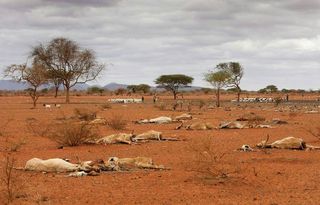
By Jemimah Chungu
In the annals of climatic history, 2023 etched its name with a dubious honor—the hottest day recorded in 120,000 years. The scorching temperatures left hundreds grappling with severe sunburn, lifelong scarring, and a slew of health complications. The Horn of Africa, particularly East Africa, bore the brunt, with a mega-drought pushing millions into the harrowing clutches of starvation and famine. As 2024 unfolds, the region holds its breath, yearning for a reprieve in the upcoming rainy season.
However, amidst the climate chaos, East Africa finds itself entangled in another perilous challenge—the construction of a crude oil pipeline by Total Energies, deemed by many as the world’s worst pipeline. Despite the immediate economic benefits, the consequences of this venture pose an existential threat to both nature and humanity in the region, with irreversible damages looming large.
The construction and subsequent mining activities near Lake Albert are sounding an alarm for the environment. The pollution, a byproduct of crude oil operations, not only imperils life in and around the water source but also undermines crucial agricultural activities and disrupts the broader ecosystem. Murchison Falls and the national park, repositories of rich biodiversity, face unprecedented jeopardy, with the pollutants reaching as far as the Tanzanian coast.
Uganda, already grappling with economic challenges, bears the social and economic brunt of crude oil development. Millions of Ugandans face displacement, as their homes are seized, and primary livelihoods, especially agriculture, are compromised. This scenario exacerbates poverty and widens economic disparities, amplifying the socioeconomic struggles of an already vulnerable nation.
The broader East African region is not immune to social challenges, with ongoing conflicts, violence, and the specter of extremist groups casting a long shadow. The Horn of Africa witnesses a surge in human displacement, with over 40 million Africans forcibly uprooted due to political and social unrest. The relief web reports a staggering 39% increase in forced displacement in Somalia, reaching a total of more than 5.1 million citizens. Ethiopia, grappling with a 26% decrease but still registering 3,422,667 forcibly displaced, continues to navigate the fallout of conflict in Tigray. The Democratic Republic of the Congo, with a 13% increase in displacement, stands at 7,141,093 total forcibly displaced, underscoring the deep-seated impact of ongoing multilayered conflicts.
Even as we look at several challenges in East Africa, the hope lingers for concerted efforts, international collaboration, and sustainable policies to address the pressing issues that threaten both the environment and the well-being of millions. The region stands at a crossroads, beckoning for solutions that balance economic development with environmental preservation and social justice.

